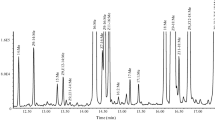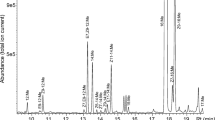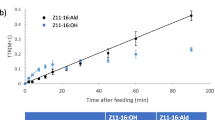Abstract
The biosynthesis of a large number of sex pheromone components of various moth species has been shown to start with common fatty acids and involve chain shortening by two carbons and introduction of a double bond at the 11–12 position. A recent report indicates that one of these common components, (E)-11-tetradecenyl acetate, is present in the eastern spruce budworm,Choristoneurafumiferana, but is not made by this pathway. Reinvestigation of this insect using in vivo and in vitro techniques indicates that the acetate indeed is made by a sequence of reactions similar to that used in other leafroller moths. In fact, evidence was found for the presence of several Δ11-desaturase systems in spruce budworm. One produced a large quantity of (Z)-11-hexadecanoic acid, and another produced (E)-11-tetradecanoic acid. It is not known if the small amount of (Z)-11-tetradecanoic acid is produced by either of those two systems or by a third system. A comparison with other species showed that cabbage looper moths have only the first system, redbanded leafroller moths use the last two systems, and European corn borer moths have all three.
Similar content being viewed by others
References
Bjostad, L.B., andRoelofs, W.L. 1981. Sex pheromone biosynthesis from radiolabelled fatty acids in the redbanded leafroller moth.J. Biol. Chem. 256:7936–7940.
Bjostad, L.B., andRoelofs, W.L. 1983. Sex pheromone biosynthesis inTrichoplusia ni: Key steps involve delta-11 desaturation and chain shortening.Science 220:1387–1389.
Dunkelblum, E., Tan, S.H., andSilk, P.J. 1985. Double-bond location in monounsaturated fatty acids by dimethyl disulfide derivatization and mass spectrometry.J. Chem. Ecol. 11:265–277.
Folch, J., Lees, M., andSloane Stanley, G.H. 1957. A simple method for the isolation and purification of total lipides from animal tissues.J. Biol. Chem. 226:497–509.
Lofstedt, C., andRoelofs, W.L. 1985. Sex pheromone precursors in two primitive New Zealand tortricid moth species.Insect Biochem. 15:729–734.
Morse, D., andMeighen, E. 1984. Aldehyde pheromones in Lepidoptera: Evidence for an acetate ester precursor inChoristoneura fumiferana.Science 226:1434–1436.
Morse, D., andMeighen, E. 1986. Pheromone biosynthesis and role of functional groups in pheromone specificity.J. Chem. Ecol. 12:335–351.
Roelofs, W.L., andBjostad, L.B. 1984. Biosynthesis of Lepidopteran pheromones.Bioorg. Chem. 12:279–298.
Roelofs, W.L., Du, J.-W., Tano, X.-H., Robbins, P.S., andEckenrode, C.J. 1985. Three European corn borer populations in New York based on sex pheromones and voltinism.J. Chem. Ecol. 11:829–836.
Wolf, W.A., andRoelofs, W.L. 1986. Properties of the delta-11-desaturase enzyme used in cabbage looper moth sex pheromone biosynthesis.Arch. Insect Biochem. Physiol. 3:45–52.
Author information
Authors and Affiliations
Rights and permissions
About this article
Cite this article
Wolf, W.A., Roelofs, W.L. Reinvestigation confirms action of Δ11-desaturases in spruce budworm moth sex pheromone biosynthesis. J Chem Ecol 13, 1019–1027 (1987). https://doi.org/10.1007/BF01020535
Received:
Accepted:
Issue Date:
DOI: https://doi.org/10.1007/BF01020535




